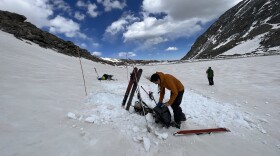-
A new document from the federal government shows how some pressure is lifted from states that use water from the Colorado River until 2026, but bigger challenges lie ahead.
-
A new study from Portland State University suggests that some of the Mountain West’s glaciers do not qualify as glaciers anymore due to their size and lack of movement.
-
New research is showing that fall snowfall can be a good predictor of what the rest of the season will look like.
-
Moderate drought conditions have come back to Colorado after the state experienced a fleeting few drought-free weeks.
-
A snowy winter and rainy spring have provided a major boost to states in the grips of drought and helped ease pressure on water managers in the Colorado River basin.
-
The Yampa River is full of snowmelt on its way to the Colorado River, bringing temporary relief for farms, fish and millions of people in the Southwest.
-
A new study out of the University of Colorado Boulder shows that less snow is falling and snow is melting earlier in the Mountain West, a trend that has big implications for agricultural, wildfire risk and water supplies.
-
The nation's second-largest reservoir has been shrinking as drought and steady demand strain the Colorado River. Lake Powell water levels are low, but canyons and ecosystems are emerging.
-
Scientists in Colorado are studying snow sublimation, in which snow evaporates before can melt into water. The new data collected will help water managers across the West understand Colorado River supply.
-
The National Interagency Fire Center's four-month outlook predicts normal wildfire activity through July across most of the Mountain West.

Play Live Radio
Next Up:
0:00
0:00
Available On Air Stations










